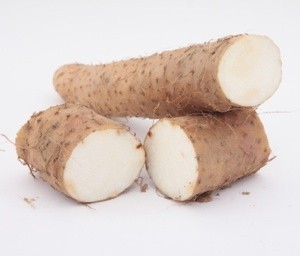
Clean the black-eyed peas in water in a large pot. Cover them with boiling water and soak them for at least an hour or overnight. After soaking them, rub them together between your hands to remove the skins, if need be. Rinse to wash away the skins and any other debris. Drain them in a colander. If the beans have soaked only a short time, they may be cooked in water over a low heat until they are partially tender. (Modern adaptation: start with canned beans, drained and rinsed.)
Crush, grind, or mash the black-eyed peas into a thick paste. Put the crushed beans in a large bowl. Slowly stir in enough water to make the paste smooth. Beat with a wire whisk or wooden spoon for a few minutes or more. It is important to incorporate small air bubbles into the paste. Heat the oil in a skillet for a few minutes, when warmed, add half the oil to the bean paste. Fry the chopped pepper in the remaining oil for a few minutes, then add pepper and oil to the bean paste. Add salt to taste and mix well.
Warm the banana leaves for a half-minute in a hot oven, or on a grill, or in a pot of boiling water. This makes them easier to fold. Remove the center rib of each leaf by cutting across it with a knife and pulling it off. Cut the ends off each leaf to form a large rectangle. Fold the banana leaves to completely enclose the ingredients in a packet two or three layers thick. (Use something like the burrito folding technique. How many leaves and how much koki you are cooking will determine how many packets to make. Use oven-proof string to tie them closed.)
Place sticks or a wire basket on the bottom of a large pot. (A stovetop steamer can be used.) Carefully stack the packets on the sticks, add enough water to steam-cook them (the water level should be below the packets). Cover tightly and boil for one to three hours. Cooking time depends on the size of the packet. The finished Koki should be cooked to the center, like a cake. Koki can be eaten hot or cold and is often served with boiled yam or sweet potato.
Combine all ingredients except the peanut butter and simmer over medium heat until everything is tender. Reduce heat, add the peanut butter and simmer for a few minutes more. Stir often. Soup should be thick and smooth.
Flavoring Add-Ins (to taste)
Vegetable Add-Ins
Meat Add-Ins
Garnishes
Heat two tablespoons of oil in a large skillet. Stir-fry the chicken (or beef) in the oil until it is browned on all sides. Remove the meat from the oil and set aside. Add the onions, the salt, pepper, cayenne pepper, and one or two of the flavoring add-ins (if desired) to the skillet and fry the mixture until the onions begin to become tender. Remove the onion mixture from the skillet and set aside with the meat.
In a Dutch oven or large covered cooking pot, bring the broth and two cups of water to a simmer. Place the meat and onion mixture into the dutch oven and cover. In the same skillet used for the meat and onions, stir-fry the tomatoes and one or two of the vegetable add-ins. Continue frying the mixture until the vegetables are partly cooked, then add them to the meat, onions, and broth in the dutch oven. Again in the same skillet, combine the rice and the tomato paste. Over low heat, stir until the rice is evenly coated with the tomato paste. The rice should end up a pink-orange color. Add the rice to the dutch oven and stir gently.
Cover the dutch oven and cook the mixture over a low heat until the rice is done and the vegetables are tender (maybe half an hour). Stir gently occasionally and check to see that the bottom of the pot does not become completely dry. Add warm water or broth (a quarter cup at a time) as necessary to help rice cook. Adjust seasoning as needed. If desired, add one of the meat add-ins while the dish is cooking. (Shrimp cook very quickly and should not be over-cooked or they will become tough; ham can be added at any time.) Serve with one or two of the garnishes.
Heat oil in large pot. Saute onions until clear. Add water and bring to boil. Add all remaining ingredients. Cook until all is tender, stirring often.
Cut yams into large serving-sized pieces. Wrap each piece in aluminum foil (or banana leaves), as one would wrap baking potatoes. Bake in a hot oven, or roast on an outdoor grill until tender. Serve with salt, pepper, and butter. Yams can also be boiled, steamed, or fried. Yams must be cooked before being eaten. Yams have a brown peel that looks like the bark of a tree. The edible, inside portion ranges from light tan or pale yellow to red or purple. When large yams are sold in grocery stores they are usually cut into pieces weighting a few pounds each and wrapped in plastic.
*Made from home-made or store-bought pie crust dough baked in a pie pan for 5-7 minutes in an oven heated to 350 degrees F (180 degrees C)
Preheat oven to 350 degrees F. In a large kitchen bowl, make the filling by blending together all of the ingredients, starting with the butter and sugar, then adding other ingredients. Pour into the baked pie shell. Cover with the pie crust strips, arranged in a criss-cross pattern, if desired. Bake in a 350 degree F oven until filling is done and crust is golden brown, 30 to 40 minutes. Serve warm, or cooled to room temperature.
Any of the following (fresh or canned):
If using canned fruits: drain and save the liquid. Peel and remove seeds from the fresh fruit as necessary, cut fruit into bite-sized pieces. Combine all fruit in a glass bowl. Add the lemon juice (or mint leaves), some sugar water (water which has been boiled, mixed with sugar, and allowed to cool--or use some of the liquid from the canned fruits). Stir gently. There should only be enough liquid to coat the fruit; it does not have to be covered in liquid. Cover the fruit salad and allow it to stand for a half hour before serving. The fruit salad may be refrigerated after it has stood for an hour. It should be eaten the same day it is made. It does not keep well overnight.
Top with grated coconut or chopped peanuts immediately before serving.
Bring the water to a near boil in a teakettle or saucepan (n.b., don't use water that has been boiling for any length of time). Pour the water into a teapot and add the tea, and then the mint leaves. Allow to the tea to steep only a few minutes. (Green teas should not be steeped as long as black teas.) Pour the tea through a strainer or use a tea infuser to separate the tea leaves from the tea. Serve immediately, with lots of sugar.
The Western African style of serving involves holding the tea pot high above the table and pouring the hot tea at least twelve inches through the air into small glasses. (Glasses made of glass, not porcelain cups.) If the sugar is added to the pot, the tea is sometimes poured from the glasses back into the pot (before anyone has sipped) and the process is repeated. This mixes the sugar into the tea. Western Africans generally drink their tea very sweet.

About The Author: Debra Frick is a mother of 5 and a grandmother to 8 grandsons and one granddaughter. She is a published author and poetress. Recycling and saving money are her passions. She also loves crocheting and cooking. She is also a pet rescue volunteer and has many pets of her own.
Add your voice! Click below to comment. ThriftyFun is powered by your wisdom!
The peanut soup sounds delicious!
Joyous Kwanzaa to you!
Can the coconut pie be made with a graham cracker crust?
Add your voice! Click below to comment. ThriftyFun is powered by your wisdom!